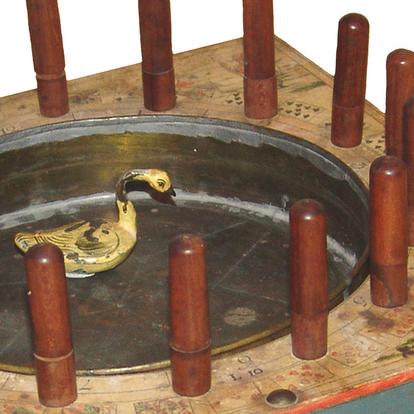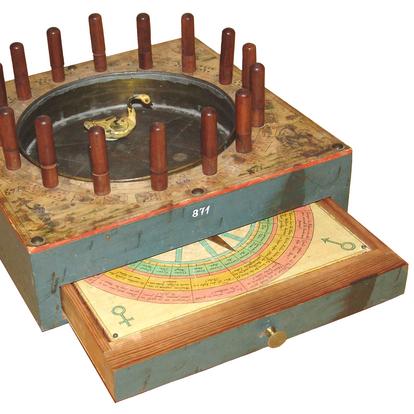HIGHLIGHTS FROM THE CABINET
AMUSEMENTS, EDUCATION AND RESEARCH
THE MAN IN THE MIRROR
Place your feet in the right place in the cabinet and you see a man in a mirror. It's hard to see where the projection comes from. The arrangement is part of Robertson's "Fantasmagorie". The Fantasmagorie was the Gothic horrorshow of the time with sliders and sound effects that made images come alive. Robertson has stated that he was only satisfied if his spectators, shivering and shuddering, raise their hands or cover their eyes out of fear of ghosts and devils dashing towards them. Both the peaceful man in the mirror and the frightening slides can be seen in the cabinet.
See the man or the slide in the instrument catalogue
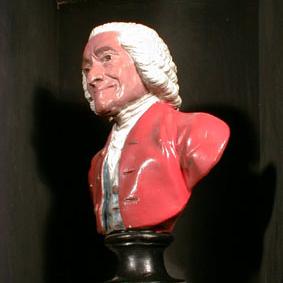
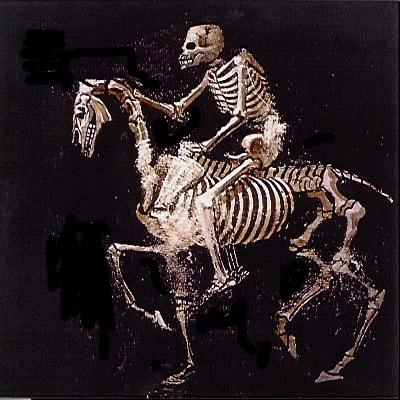
THE ELECTROSTATIC GENERATOR
In the early days, it was possible to produce electricity by rubbing, for example, Amber against cat furs. But only generated limited amounts of electricity. In 1663, van Guericke realized that one can generate electricity by putting a hand on a rotating glass ball. Around 1730, such electrostatic generators had developed into efficient machines that generated electricity with rotating glass plates. This gave rise to the interest in understanding what electricity is. Experiments were carried out and people entertained by electrical toys.
Hauch’s large plate machine has a glass plate with a diameter of 90 cm and can produce a potential difference of up to 100.000 V.
Read more about the Large Plate Machine in the Instrument Catalogue
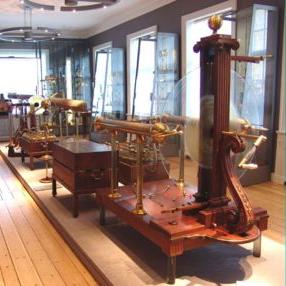
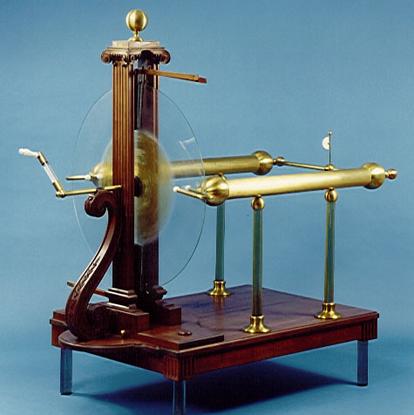
THE ELECTRIC CHIMES
The electric chime is amongst the many electric toys that visitors to the cabinet can see. The chimes work in the following way: You respectively connect an electrostatic generator to the middle and top of the electric chimes. When turning the crank of the electrostatic generator and generate electricity, the chimes in an almost magical way, begin to ring. Why? If the middle column is positive and the bells are negative, a slightly negative ball in an insulated wire will seek towards the positive column, touch this, become positive and then seek against the negative bell. When touching this, it becomes negative and again seeks against the positive middle, etc. Thus the bells begin to ring with the most pleasing sound.
Read more about The Electric Chimes in the Instrument Catalogue
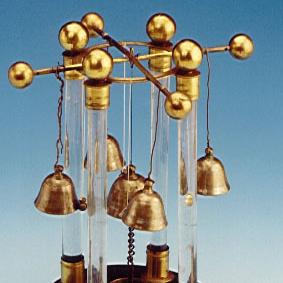
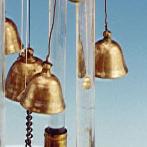
IS WATER A CHEMICAL ELEMENT?
This issue was one of the hottest scientific issues at the end of the 17th century. The old chemists claimed that water was a chemical element. The founder of modern chemistry, Antoine-Laurent de Lavoisier, claimed it was not. Lavoisier designed a gasometer that showed that you could form water by directing hydrogen and oxygen gases into a chamber with electrical discharges. Hence, it could not be an element. Hauch asked the French instrument maker Dumotiez to make a simpler and cheaper gasometer, according to his instructions. Hauch experimented with great thoroughness with Gasometer, published his results in the Proceedings of the Royal Danish Society in 1793 and later in foreign journals.
Read more in the Instrument Catalogue. Please search for Gasometer
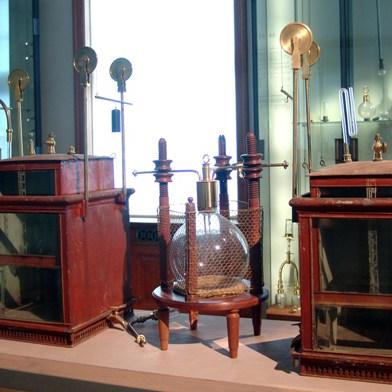

ATWOOD’S MACHINE
The Atwood machine was invented by the English mathematician George Atwood in 1784. The instrument is used to illustrate the principles of classical mechanics concerning tension force and
motion with constant acceleration, based on Newton's second law. It is even a common classroom demonstration tool today.
The main components of the machine usually comprise a pulley, a string and two weights. In this system, you have to find out if the weights will accelerate, how much, in which direction and what the traction force will be.
Read more about Attwood’s Machine in the Instrument Catalogue
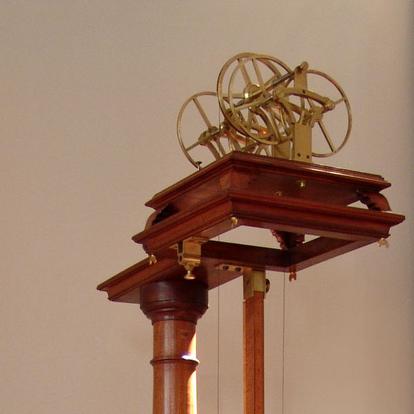

THE MAGICAL FOUNTAIN
The magical fountain was an entertaining feature in Enlightenment natural magic performances. The upper glass container is filled with water. When the water flows out of the four brass tubes below the container, the water jets create a beautiful fountain. But suddenly the water stops running. After a while, it starts running again. In this way, the fountain stops and starts at certain intervals until the glass container is completely emptied. With good timing, you could give the amazed audience the impression that you started and stopped the fountain alone by the power of thought.
The explanation for what happens it be found at the bottom of the glass tube carrying the glass container. When water is splashing down from the four nozzles at the top to the middle brass tray, the water runs down faster than it can run down in the lower brass tray. At some stage, the air flow is blocked to the glass tube at the bottom. This causes the water from the four nozzles to stop running. After a while, when the middle tray is sufficiently emptied, the air supply is restored, the water from the four nozzles flow again and the process is repeated.
Read more about the magical fountain – the Intermittent Fountain - the in the Instrument Catalogue
Forklaringen skal findes nederst ved det glasrør, der bærer glasbeholderen. Når der sprøjter vand ned fra de fire dyser øverst, til den mellemste messingbakke, løber vandet hurtigere ned på denne, end det kan løbe videre ned i den nederste messingbakke. På et tidspunkt blokeres lufttilførslen til det bærende glasrør nederst. Dette medfører at vandet fra de fire dyser stopper med at løbe. Efter et stykke tid tømmes det mellemste kar, lufttilførslen genoprettes, vandet springer igen fra de fire dyser igen og processen gentages.
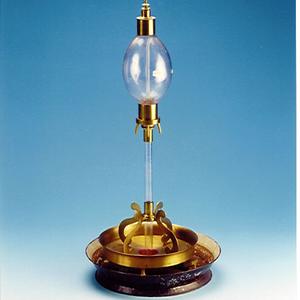
THE FIRST DANISH KILOGRAM WEIGHT
The French Revolution not only changed the political system. The French also standardised the dimensions and weights based on the decimal system. The first kilogram weight was introduced in 1795. The Danish astronomer Thomas Bugge was sent to France several times by the Danish king to participate in the work and received two kilogram weights. The king got one and gave it to Hauch. You can see it today in the collection.
Read more about the Kilogram Weight in the Instrument Catalogue
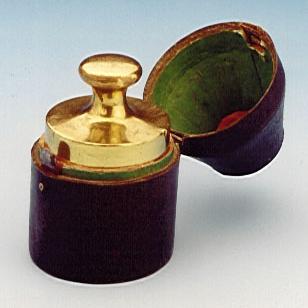
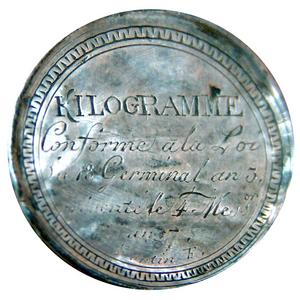
AIR PUMPS
The cabinet contains a number of air pumps. The air pump was invented in 1649, commercialized in the middle of the 1670s and came to play a major role in experimental science. Many things were stuffed under the glass bell to investigate what happened when the air was pumped out: burning candles, barometers, pigeons, mice and even cats etc. The effects could be seen but what happened when you pumped? Was all the air pumped out? Some thought yes, while others did not think that a pure vacuum could be created.
See the Faucet Air pump and Smeaton’s improved air pump in the Instrument Catalogue
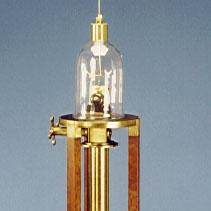
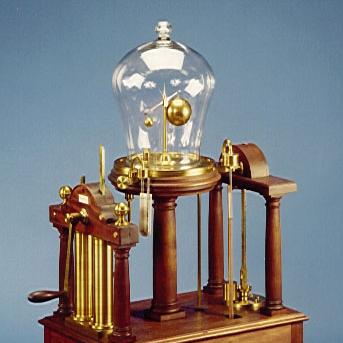
AVOID UNWHOLESOME AND DEADLY EXHALATIONS
The eudiometer was one of the instruments that Hauch improved. It was used to measure the ‘goodness’ of the air. As Hauch wrote in the Proceedings of the Royal Danish Society in 1793: "Clean and healthy air is as necessary for man’ as healthy and nutritious food’. One should avoid ‘unwholesome and deadly exhalations’
The Eudiometer determines the oxygen content of the air. Hauch improved model is distinguished by the fact that you do not have to ‘get your fingers wet, let alone bringing your hands and arms under water’. In the instrument, atmospheric air is mixed with nitric air. The oxygen in the air sample enters a chemical compound and the volume is reduced. The greater the reduction in volume, the more oxygen in the air.
Read more about Hauch's Eudiometer in the Instrument Catalogue
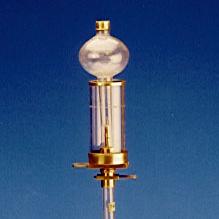
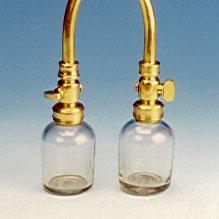
PASSEVIN
As at the time of Jesus, you can experience water being transformed into wine in the Cabinet.
Or rather: You fill bottle A with red wine before the guests come. Preferably a good vintage. While the guests are looking water is filled in the glass B. As water has a greater density than wine, it sinks through the pipe C, pushes up the wine, and then the wine can be served.
See more in the Instrument Catalogue
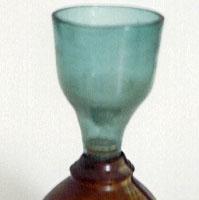
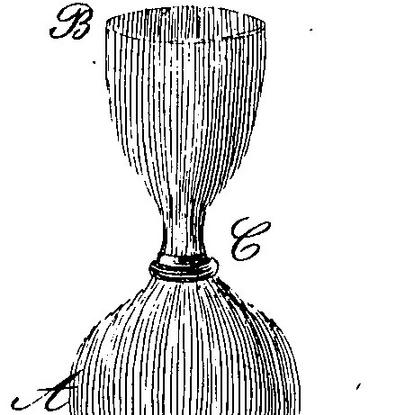
THE WIRZ PUMP
In 1746 pewterer Wirz invented a very efficient pump. It was later forgotten and later reinvented by some students at the Niels Bohr Institute and came to Tanzania as part of a development program.
Back in the 18C, the pump was given a great deal of attention because it was so effective. Hauch wrote that it could lift 47 ½ jugs of water to 100 foot in 2 minutes. How? Fill the water in the tub at the bottom and turn the crank. Alternating portions of water and a portion of air enter into the spiral-shaped tube. The water and air pockets press each other through a vertical glass tube and the water is lifted.
Try it in the Cabinet or read more about it in the Instrument Catalogue.
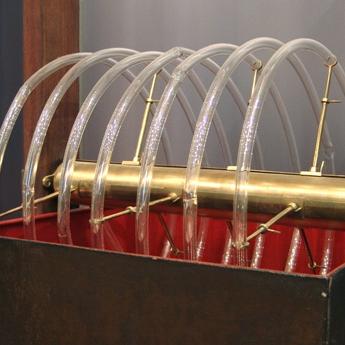

THE WISE SWAN
The swan swims in a small swimming pool in a richly decorated box. A random playing card is drawn. On the question plate, the pointer is directed towards the card. The question is read aloud.
For instance, for Nine of Diamonds, the question is: ‘Why has nature not equipped women with beards?’. The question plate is put in place in the box under the Swan, and to everyone's surprise, the Wise Swan swims and nominates a pole with its beak. The answer can be found inside the pole: ‘Because they can't remain silent long enough to be shaved.
The secret behind the swan lies in a bar magnet that is built into the question plate. The apparatus is an example of entertainment or natural magic in the cabinet. Read more in the Instrument Catalogue.
